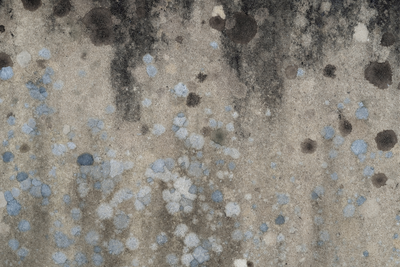Could mould be the cause of your mystery health issues?

Though odourless and invisible to the naked eye, mycotoxins (toxic microscopic particles produced by mould) can cause illness, allergy and disease.
Mycotoxin exposure can produce a confusing array of symptoms and affect almost any system in the body, from lymphatic to digestive. Studies show that mycotoxins have even been found in breast milk.[1]
Mould expert Michael Rubino says that “as the contaminated air is inhaled over time, it can lead to mould toxicity in the body, which is when the body has been exposed to so much mould that the immune system is unable to remove it. This can cause chronic inflammation, which can lead to chronic inflammatory response syndrome (CIRS).”
“Mould or mycotoxicity is a great mimic, so it can so easily be missed or misdiagnosed” explains Tara Williams, founder of Conscious Spaces. “That’s why it’s vitally important to work with an experienced practitioner to get the right tests to pinpoint the issue, decipher the results and get an appropriate treatment plan in place.”
What are the symptoms of mould toxicity / mould illness / mycotoxicosis?
Whilst the symptoms of toxic mould exposure are incredibly diverse, some of the most common[2] include:
General: Inflammation, sleep issues, fatigue, weight changes, light sensitivity
Digestive: IBS, bloating, vomiting, diarrhoea, acid reflux
Cognitive: Anxiety, depression, irritability, ‘brain fog’, memory problems, slurred speech, recurring nightmares
Neurologic: headaches, tingling, dizziness, numbness, lightheadedness, pins and needles
Musculoskeletal: Muscle and joint pain, muscle twitches, cramps, weakness, stiffness
Hormonal: Night sweats, poor temperature regulation, excessive thirst or needing a wee
Skin: Rashes, fungal infections
Respiratory: sinus issues, excess mucus, needing to clear your throat regularly
It’s also thought that mould toxicity can exacerbate existing autoimmune conditions like Lyme disease, Lupus and Small Intestine Bacterial Overgrowth (SIBO).[3] Many scientists have also connected chronic fatigue syndrome (CFS) and ME to mycotoxin exposure and the resulting mitochondria damage.[4]
Is mould allergy the same as mould toxicity / mycotoxicosis?
Some people experience allergies to mould spores, with typical allergic symptoms such as nasal congestion, a runny nose and itchy eyes, shortness of breath or sinus issues (similar to hay fever). But mould allergy is not the same as mould toxicity or mycotoxicosis, which can be acute, chronic and even deadly.[5]
Are some people more susceptible to mould illness than others?
In a word, yes. Your diet, age, genetics, immune health, stress levels, gut health, toxic load (and ability to detox effectively), your sleep quality – all of these things can make you more or less vulnerable to the effects of mould and mycotoxins. Another key factor is how long you’re exposed to the mould and how toxic the mould you’ve been exposed to is.
Two people could be living in the same mouldy house, with one unaffected by mycotoxins and the other suffering a barrage of symptoms – because no two bodies are the same, and how toxins manifest in our systems can be wildly different for each individual.
“Approximately 24% of the population are genetically susceptible to mould illness, and their immune system is not able to easily eliminate mycotoxins,” says Tara.
How is mould toxicity or mould illness diagnosed?
It can be tricky to accurately link the many symptoms mould can produce to exposure to mycotoxins. “Not only is mould a great imitator of different health issues but it can also trigger or perpetuate the symptoms of other health problems, including asthma, allergies, and coinfections,” explains functional medicine practitioner Will Cole.
But there are tests you can do, including blood tests for certain immune markers and hormones (these usually have to be carried out via a functional medicine practitioner). You can also take a urine sample test for mycotoxins. The Great Plains Laboratory mycoTOX Profile test, for example, tells you more about your specific mould issues by identifying which mycotoxins you have in your system.
“Whilst the urine test is a great marker for mould toxicity, if someone is able to excrete these mould toxins in their urine, it’s a sign that they have a fair to healthy internal detox process,” says Tara. “However, for some people who might not have such a good immune response or natural ability to get rid of the mould toxins, mycotoxins may not show up on a urine test – so it’s important to always work with a mould toxicity specialist and to use the appropriate array of tests if you suspect you might be vulnerable.”
Tips for treating mould illness and symptoms of mould exposure
“If you think you might be suffering from mould toxicity, it’s incredibly important that you treat it in the right order – particularly if you suffer from co-infections like Lyme or you have ME,” says Conscious Spaces founder Tara Williams.
“Dr Jill Carnahan discusses the importance of calming of the limbic system (the part of the brain involved in our behavioural and emotional reactions) in patients with mould toxicity, as the mould can create a physiological response and initiate the fight or flight response within the nervous system.”
Dr Carnahan recommends prepping the limbic system by using things like craniosacral therapy, binaural beats, and neurofeedback to pave the way for the best chance of recovery from mould toxicity.
The next step on the road to recovery, says Tara, “is addressing toxicity,” as well as looking into specialists to help effectively remove the mould from your environment (more on that in our next article). “If you have symptoms of mould toxicity, always ask someone else to clean any mould and wear an appropriate builders' mask whenever you think you may be exposed. You want to do everything possible to avoid mast cell activation.”
Here’s how to address mould toxicity and start to regain your health:
- Make sure your gut is in a good state. If your microbiome is imbalanced (perhaps because of poor diet, lack of sleep or stress), then your gut health – and immune system – is compromised, leaving you more vulnerable to the effects of toxic mould exposure. Discover how to support your microbiome in this article.
- Optimise your body’s natural detox systems. Whether from the air we breathe, the things we eat and drink, or the products that touch our skin, our bodies face a daily barrage of toxins and chemicals. Although we eliminate toxins through pee, poo and sweat, they can still build up, creating a bodily burden known as a ‘toxic load’. If your body is already overburdened with toxins, once you add mycotoxins from mould into the mix, it’s going to struggle to remove them safely from your system and not reabsorb the toxins. Help your body detox as effectively as possible by staying hydrated, eating well and sweating regularly (e.g. through exercise or an infrared sauna).
- Include certain supplements in your daily routine to help detox your liver and rebalance your immune system, such as the powerful antioxidant glutathione (or, if you are sensitive to this, try the precursors of glutathione such as NAC or selenium), milk thistle and vitamins A and E.
- Try adding more natural antifungals to your diet, like oregano, thyme, turmeric and cinnamon and rosemary.
- Avoid food that can be prone to mould contamination, like coffee (try Exhale organic coffee instead, which is independently tested to be mycotoxin-free), peanut butter, dried nuts and fruits and herbs and spices.
- Cut down on sugar and sugary, starchy foods (sugar encourages candida and mould growth). When reading food labels, steer clear of anything that contains glucose, sucrose, lactose and fructose. If in doubt, stick to whole, natural foods with zero added sugar.
- Binders such as clay, activated charcoal (only for short periods of time as this binds to minerals as well as mould toxins), fibre and chlorella can help mop up any mould toxins that might be lurking in the gastrointestinal tract, eliminating them via bile and stools.[6]
But the best way to prevent mould illness? Get to the root of the problem and remove the mould in your environment – or stop it growing in the first place. Find out how in our next article.
References
[1]https://www.sciencedirect.com/science/article/abs/pii/S0924224419302389#:~:text=Background,dietary%20mycotoxins%20by%20lactating%20mothers.
[2] https://www.ncbi.nlm.nih.gov/pmc/articles/PMC4982651/
[3] https://goop.com/gb-en/wellness/health/mold-in-your-home/
[4] https://www.ncbi.nlm.nih.gov/pmc/articles/PMC3705282/
[5] https://www.sciencedirect.com/topics/pharmacology-toxicology-and-pharmaceutical-science/mycotoxicosis
[6] https://www.greatplainslaboratory.com/gpl-blog-source/2021/20/mycotoxinbinders






































